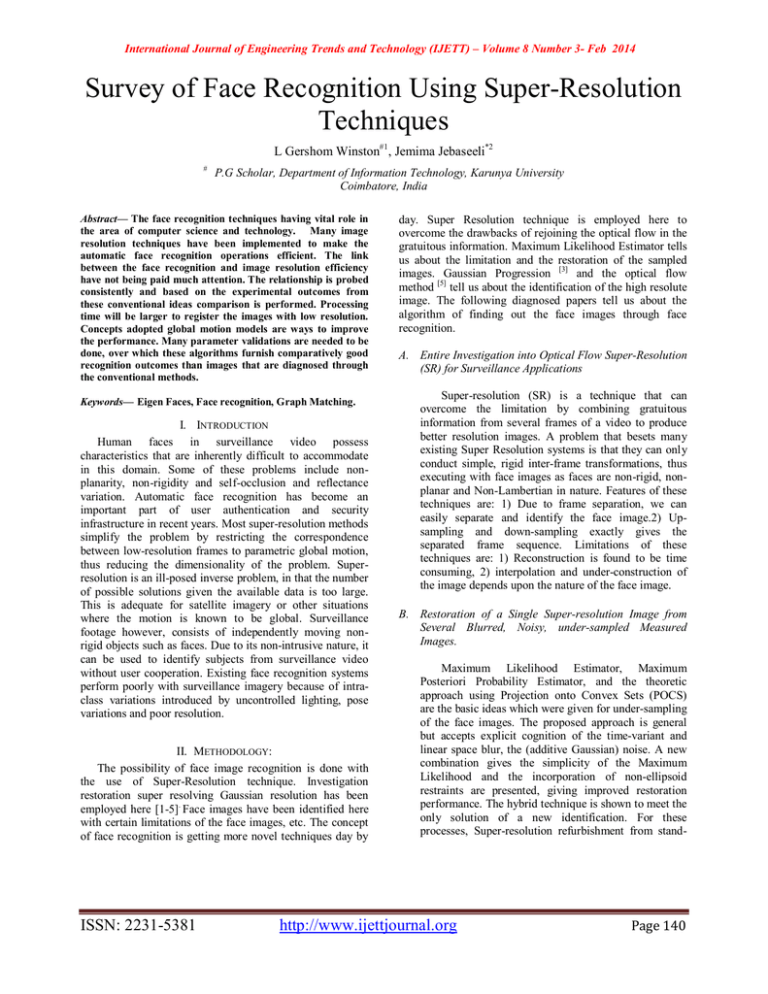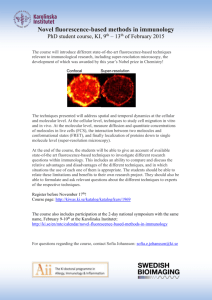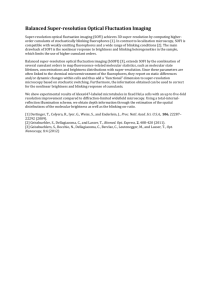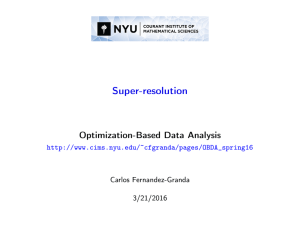Survey of Face Recognition Using Super-Resolution Techniques L Gershom Winston
advertisement

International Journal of Engineering Trends and Technology (IJETT) – Volume 8 Number 3- Feb 2014 Survey of Face Recognition Using Super-Resolution Techniques L Gershom Winston#1, Jemima Jebaseeli*2 # P.G Scholar, Department of Information Technology, Karunya University Coimbatore, India Abstract— The face recognition techniques having vital role in the area of computer science and technology. Many image resolution techniques have been implemented to make the automatic face recognition operations efficient. The link between the face recognition and image resolution efficiency have not being paid much attention. The relationship is probed consistently and based on the experimental outcomes from these conventional ideas comparison is performed. Processing time will be larger to register the images with low resolution. Concepts adopted global motion models are ways to improve the performance. Many parameter validations are needed to be done, over which these algorithms furnish comparatively good recognition outcomes than images that are diagnosed through the conventional methods. Keywords— Eigen Faces, Face recognition, Graph Matching. I. INTRODUCTION Human faces in surveillance video possess characteristics that are inherently difficult to accommodate in this domain. Some of these problems include nonplanarity, non-rigidity and self-occlusion and reflectance variation. Automatic face recognition has become an important part of user authentication and security infrastructure in recent years. Most super-resolution methods simplify the problem by restricting the correspondence between low-resolution frames to parametric global motion, thus reducing the dimensionality of the problem. Superresolution is an ill-posed inverse problem, in that the number of possible solutions given the available data is too large. This is adequate for satellite imagery or other situations where the motion is known to be global. Surveillance footage however, consists of independently moving nonrigid objects such as faces. Due to its non-intrusive nature, it can be used to identify subjects from surveillance video without user cooperation. Existing face recognition systems perform poorly with surveillance imagery because of intraclass variations introduced by uncontrolled lighting, pose variations and poor resolution. II. METHODOLOGY: The possibility of face image recognition is done with the use of Super-Resolution technique. Investigation restoration super resolving Gaussian resolution has been employed here [1-5]. Face images have been identified here with certain limitations of the face images, etc. The concept of face recognition is getting more novel techniques day by ISSN: 2231-5381 day. Super Resolution technique is employed here to overcome the drawbacks of rejoining the optical flow in the gratuitous information. Maximum Likelihood Estimator tells us about the limitation and the restoration of the sampled images. Gaussian Progression [3] and the optical flow method [5] tell us about the identification of the high resolute image. The following diagnosed papers tell us about the algorithm of finding out the face images through face recognition. A. Entire Investigation into Optical Flow Super-Resolution (SR) for Surveillance Applications Super-resolution (SR) is a technique that can overcome the limitation by combining gratuitous information from several frames of a video to produce better resolution images. A problem that besets many existing Super Resolution systems is that they can only conduct simple, rigid inter-frame transformations, thus executing with face images as faces are non-rigid, nonplanar and Non-Lambertian in nature. Features of these techniques are: 1) Due to frame separation, we can easily separate and identify the face image.2) Upsampling and down-sampling exactly gives the separated frame sequence. Limitations of these techniques are: 1) Reconstruction is found to be time consuming, 2) interpolation and under-construction of the image depends upon the nature of the face image. B. Restoration of a Single Super-resolution Image from Several Blurred, Noisy, under-sampled Measured Images. Maximum Likelihood Estimator, Maximum Posteriori Probability Estimator, and the theoretic approach using Projection onto Convex Sets (POCS) are the basic ideas which were given for under-sampling of the face images. The proposed approach is general but accepts explicit cognition of the time-variant and linear space blur, the (additive Gaussian) noise. A new combination gives the simplicity of the Maximum Likelihood and the incorporation of non-ellipsoid restraints are presented, giving improved restoration performance. The hybrid technique is shown to meet the only solution of a new identification. For these processes, Super-resolution refurbishment from stand- http://www.ijettjournal.org Page 140 International Journal of Engineering Trends and Technology (IJETT) – Volume 8 Number 3- Feb 2014 still measurements is also derived. Features of this algorithm includes: 1) the algorithm supports motion free estimation and detection 2) measurement is done through separating regularized and non-regularized regions for frequency domain analysis. Limitations of this algorithm including 1) computational complexity in deriving the mathematical model for hybrid restoration method 2) techniques and algorithms are new to learn so difficult in deriving the terms. C. Single image super-resolution using Gaussian process regression Each pixel is anticipated by its neighbours by Gaussian process regression. Using proper co-variance identification, the Gaussian process fixation can perform clustering of pixels depending on their local structural elements. The demonstration of this algorithm can derive the basic information comprised in a single low-resolution signal to generate a high-resolution of the same with sharp edges, which is comparatively superior in quality and performance of other edgedirected resolution algorithms and other techniques. Features of this algorithm including 1) Gaussian tool reduces noise as much as possible2) the co-variance and super-resolution values give us the exact image located. Limitations of this algorithm including 1) the Gaussian Progression (GP) values only supports the mapping ranges 2) reconstruction and performance are little bit moderate as compared. E. Super-Resolved Face Images using Robust Optical Flow Biometrics such as hand sign recognition, face recognition, Gesture recognition based research is a fast moving field because of the drastic demand on identification or authentication of an individual. Somehow, only identification documents can be identified. Super-resolution algorithm has undergone a great success in a wide variety such as satellite imagery, medical imaging and some pattern recognition applications. Rather, biometrics has revealed a wide range of human-based features and characteristics which will be useful to authenticate an individual. Features of these algorithm includes: 1) Illumination can be avoided and motion compensation can be done 2) De-blurring is achieved at a concern and authentication is done with high efficiency. Limitations of this algorithm including: 1) interpolation for filter techniques and face identification due to interpolation makes pixel identification complex 2) Biometric identification is the oldest idea and super resolution techniques for all the biometric are not supported. D. The Role of Motion Models in Super-Resolving Surveillance Video for Face Recognition Though the application of super-resolution techniques has showed the power to make face recognition efficient, they are difficult to be implemented for real-time applications due to their complexity and computational complexity. As drastic portion of working time is given to low resolution images, techniques have adopted global motion examples to make them efficient. The retreat of many global features is that they cannot adapt the complex local features, say, multi-objects moving and tracking, static or dynamic background that presents in a surveillance conditions. Features of these techniques including 1) Eigen face approach gives us the accurate identification of the face images comparatively 2) The standardized implementations can be given for many research databases using this technique. Limitations of this technique are there is no much explanation about the concept of super resolution in motion surveillance. ISSN: 2231-5381 http://www.ijettjournal.org Page 141 International Journal of Engineering Trends and Technology (IJETT) – Volume 8 Number 3- Feb 2014 TABLE I COMPARISON TABLE Investigation into Optical Flow Super-Resolution (SR) for Surveillance Applications Restoration of a Single Super-resolution Image from Several Blurred, Noisy, undersampled Measured Images Single Image SuperResolution using Gaussian Process Regression The Role of Motion Models in Super-Resolving Surveillance Video for Face Recognition Super-Resolved Face Images using Robust Optical Flow Face image acquisition Super-Resolution Image restoration Recognition through Super Resolution Gaussian Process Progression Multi-object tracking Eigen Face approach Biometric Recognition Interpolation Methodology Super resolution using motion compensation Maximum Likelihood Estimator Gaussian Progression and fixation Eigen values and Eigen face detection Algorithm Super Resolution with frame separation Super Resolution and Restoration Gaussian fixation Frame separation and Super Resolution through conventional algorithm Biometric through motion compensation and interpolation Registration and Restoration Input Surveillance Image Noisy Image Single Dimensional Image Eigen Face Images Video/Frame separated Image Output Recognized face image Enhanced Image High Resolution Image Multi face images Recognized multi faces Factors affects detection and extraction Interpolation disturbs the faces Problem in restoration – blurring occurs slightly Gaussian Progression leads to less concentration in reconstruction Super resolution in motion surveillance has some defects Pixel identification makes complex Goal Approach Maximum Likelihood III. CONCLUSIONS A suitable Super-Resolution (SR) system gives us a little borderline improvement over interpolation in the absence of noise. More additional techniques can be gained and realized when the images are noisy, as the frame-fusion process helps to decrease the noise level. The super resolution algorithm is not that much robust to adapt the localization errors. ISSN: 2231-5381 REFERENCES [1] [2] Fookes, A. Maeder, Comparison of popular non-rigid image registration techniques and a new hybrid mutual information-based fluid algorithm, in: Proceedings of the APRS Workshop on Digital Image Computing, 2003. B. Gunturk, A. Batur, Y. Altunbasak, M.H. III, R. Mersereau, Eigenface-domain super-resolution for face recognition, IEEE Transactions on Image Processing 12 (2003) 597–606. M. Wegmuller, J. P. von der Weid, P. Oberson, and N. Gisin, “High http://www.ijettjournal.org Page 142 International Journal of Engineering Trends and Technology (IJETT) – Volume 8 Number 3- Feb 2014 [3] [4] resolution fiber distributed measurements with coherent OFDR,” in Proc. ECOC’00, 2000, paper 11.3.4, p. 109. A. Lemieux, M. Parizeau, Experiments on Eigen-faces robustness, in: Proceedings of ICPR-2002, vol. 1, 2002 F. Lin, C. Fookes, V. Chandran, S. Sridharan, Investigation into optical flow super-resolution for surveillance applications, in: ISSN: 2231-5381 [5] [6] Proceedings of APRS Workshop on Digital Image Computing 2005, 2005. E. Bailly-Bailliere, S. Bengio, K. Messer, The BANCA database and evaluation protocol, in: Proceedings of AVBPA-2003 S. Baker, T. Kanade, Super Resolution Optical Flow, Tech. Rep. CMU-RI-TR-99- 36, The Robotics Institute, Carnegie Mellon University, October 1999. http://www.ijettjournal.org Page 143






